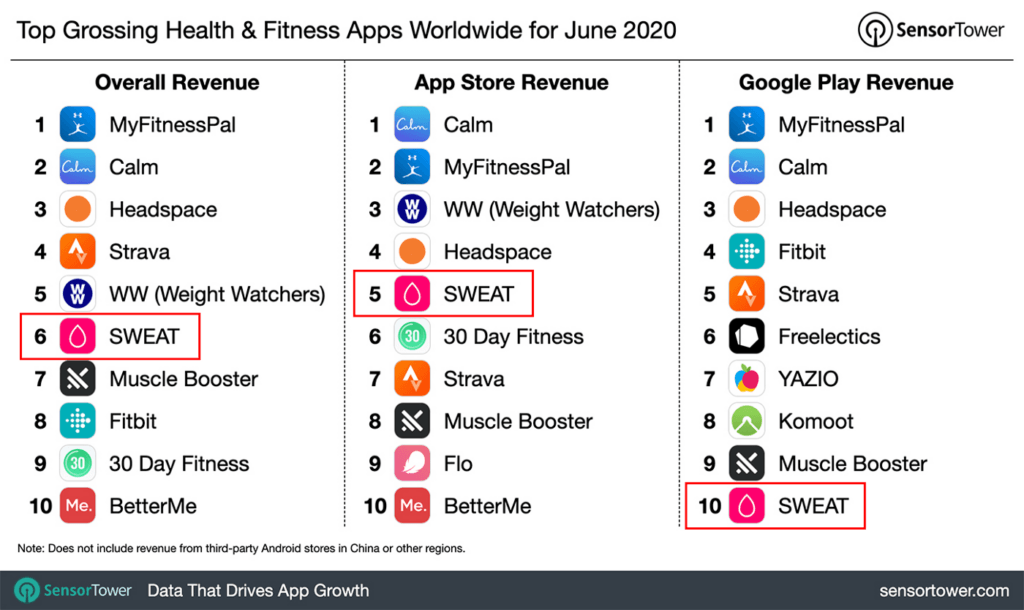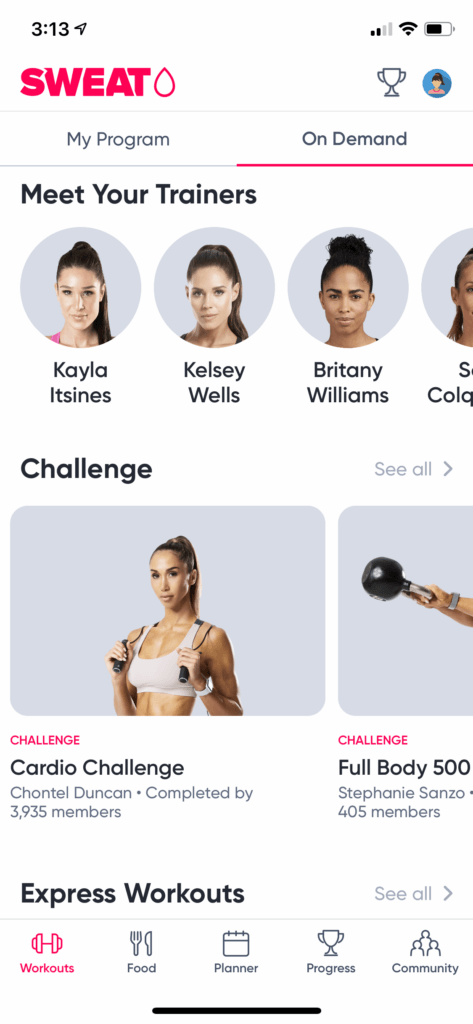Adding Value Through Sweat…The Fitness App That Keeps You Working Out

Sweat is a fitness app that has leveraged a mobile app platform to deliver tough and effective workouts for 1 million active users.
Fitness has long been a key part of our lives, but much more common than hearing individuals boast about their achievements, is hearing about the struggles of maintaining a workout routine. More often than not, fitness is the first item on the to-do list to be scrapped, whether due to time constraints, loss of motivation or even a lack of knowledge on how to design an effective workout.
Sweat, a platform-based app launched in November 2015, has sought to remove some of the friction around fitness, and in doing so has created huge amounts of value. [1] In fact, with the 6th highest revenue of health and fitness apps in June 2020, Sweat generates annual sales of about $100 million with 1 million active users per month, myself included. [2]
Figure 1 Top grossing health and fitness apps worldwide in June 2020 [3]
Sweat creates value by providing easy access to effective workouts and simulating the accountability of a personal trainer. The Sweat app has curated several qualified and motivational trainers, including its well-known founder Kayla Itsines, who serve as the platform’s backbone. These trainers design programs and workouts to fit the heterogenous needs and preferences of app users. For example, users can choose workouts based on the type of training (e.g. cardio, strength, high intensity interval training (HIIT) and pilates), the timing of the workout (ranging from 10 minutes and up), the length of the fitness program (e.g. several weeks or on demand), and the type of equipment available to the user.
Figure 2: Sweat app layout with user’s workout and tabs for food tracker, planner with scheduled workouts, progress and community engagement [4]
With the Sweat app available globally, these workouts can be started and completed at any time of the day since they are all accompanied with videos to follow along as well as timers and audio cues to transition to different exercises. Additionally, the Sweat app provides the users with a calendar schedule based on the program selected which helps to create routine and accountability for users so that they don’t skip workouts. There are also options to log other workouts completed outside the app for a full view of the user’s fitness journey, track meals and calories and connect with the community of Sweat users.
Overall, these features of the app make it significantly easier for individuals to workout no matter the circumstances because they always have their phones with them. Gone are the days where individuals have to find a gym, hire a personal trainer that meets their needs, align on scheduling and physically travel to the gym whenever they wanted to work out. The Sweat app has made it possible for users to complete tough training sessions without being a member of a gym or having a personal trainer.
Figure 3: Sweat app exercise instructions, videos and audio cues simulate the experience of having a personal trainer with the advantage of being available anytime and anywhere
While workout apps are common, there are few that deliver the value that Sweat does through high-quality, influential trainers, priming and standardizing of videos, and a wide range of workouts and programs. Sweat has therefore created a competitive advantage that has raised customers willingness to pay and the app captures this value by charging $19.99 for a monthly subscription. [5] This is higher than other health and fitness apps including Peloton, which charges $12.99 for a monthly digital membership and MyFitnessPal which charges $9.99 per month. [6], [7]
Sweat has shown remarkable growth, with revenue up about $23 million since 2018 [8]. The pandemic also resulted in fitness apps downloads growing by 46% with a 24% increase in daily active users. [9] These staggering figures would no doubt have contributed to Sweat’s growth. But beyond the pandemic, the Sweat app is extremely scalable since it leverages mobile app and platform technology making it accessible to trainers and users anywhere in the world. Also, the Sweat app requires no other equipment, unlike competitors such as Peloton who have made a brand out of physical bikes and are now trying to break into the equipment-free segment. Although there are currently only ten female trainers, there is the option to expand this platform to include even more trainers and perhaps onboard male trainers to appeal to men who are looking for more structure to their fitness regimes.
Figure 4: Sweat App’s trainers and workout options cater to the female segment but there are opportunities to scale and expand to other segments
While it may at first seem easy to copy Sweat’s strategy, I think it will be very difficult for a new entrant or competitor to achieve the same success. This is because Sweat has already penetrated the market and built a brand. Multi-homing in the fitness app industry is less common since there is a relatively high cost associated with each app and there is limited time each day for workouts. In addition to these barriers to entry, Sweat has the advantage of growing by word of mouth from its 1 million active monthly users and can secure its leading position by leveraging the data it has collected to innovate and expand to new segments of the market. Amidst a growing number of apps in the fitness arena, Sweat has already proven its sustainability because it makes a difference in users’ lives and in the metric of health that is priceless.
Endnotes
[4] https://www.pixelforce.com.au/pages/sweat-app
[5] https://join.sweat.com/en/signup/new
[6] https://www.cnbc.com/2020/09/15/peloton-thinks-it-can-grow-to-100-million-subscribers-heres-how.html
[7] https://www.myfitnesspal.com/premium?source=menu_bar
[9] https://www.weforum.org/agenda/2020/09/fitness-apps-gym-health-downloads






Hi Tiffany, thanks for this very interesting post! I’ve never used Sweat but I bought Kayla’s book back in 2015!
I’m curious to hear your opinion on Sweat’s pricing strategy in a post-covid world. Considering the increased competitions generated by the high number of home-workout apps or Zoom live classes, do you think that Sweat’s higher price is sustainable in the long term?
Thank Giulia! I actually do think the higher price is sustainable in the long term because more and more people are realizing that at-home workouts using apps are as effective as workouts in the gym. Therefore I think that the comparison isn’t between apps but between a high quality app and a gym membership/trainer. Since Sweat offers a superior quality workout, I think that users will continue to pay $20 per month (or $10 per month for an annual subscription) since this is significantly cheaper than any gym membership or personal trainer. As Tim suggested below, there may even be an option for Sweat to offer a more expensive premium service with live trainers or group sessions.
Thanks Tiffany, very interesting read. Would love to know your opinion on focusing on women vs opening to the male segment as well. At first glance it seems like a no-brainer – in theory you basically double your user base if you effectively cater to men. However, maybe the brand has done so well (and can command higher prices) precisely because of its female focus. Definitely a tough decision to make, very interested to know which direction they will decide to take.
Thanks Rolando. That is a great question! I think that Sweat focused on female users to start because it was easier to find product market fit. As Giulia mentioned above, Sweat evolved from selling a PDF of the Bikini Body Guide (BBG). They had user base through females wanting to get fit and toned. As they have proven their success in the online app though, I think they should add male trainers and offerings for men. In my opinion, the workouts are tough already but for the guys who may think it is too girly, they should had add more hardcore lifting programs or other workouts that appeal to males.
Great post, Tiffany! I am curious to see how much for the growth the industry has experienced during the COVID-19 pandemic was captured by Sweat. I would not be surprised if Peloton and other competitors that cross sell their fitness apps with work out products saw most of the industry’s growth. Also, what are your thoughts on disintermediation? I am curious what stops Sweat’s star trainers, such as Kayla, from leaving the platform and offering a standalone product?
Thank you Vartan! I am also curious to know how much growth in the fitness app industry was captured by Sweat but unfortunately I haven’t been able to find that data. I do see your point that customers may have wanted more integrated solutions including equipment due to the lockdown but I think one of the benefits of Sweat is that workouts can be done anywhere. In normal times, this is a huge advantage when you’re traveling, don’t have the space for an at-home gym or simply can’t afford or access programs like Peloton (e.g. internationally). In terms of disintermediation, I think Sweat provides enough support services and benefits to trainers that leaving the platform would be disadvantageous. Sweat has significantly increased the visibility and popularity of trainers on the app since the ads for their programs and workouts reach over 1 million users per month (new trainers generally have under 200k Instagram followers). This likely boosts the trainers compensation as well.
The concept of Sweat is very interesting. Thanks Tiffany for sharing.
Like the entire health and wellness industry, Sweat if benefiting from a booming market. The pandemic gave Sweat another boost. This said, one day, this growth will come to an end. In this respect, I am wondering how Sweat will increase its revenue per user in order to further improve its financial performance. Further increasing price doesn’t seem obvious while changing its current “one-price-fits-all” policy into a basic and premium subscription might lead to customer frustrations.
Thanks Tim! I think that you make a great suggestion. I believe there is a market for Sweat to offer a premium higher priced service with access to live workout classes or one-on-one virtual training sessions. For this to happen, Sweat would likely have to increase the supply side of their marketplace so that there are more trainers available for live individual sessions and this may have an impact on the quality of the service. I also think that Sweat’s revenue is most at risk to very large platform players such as Apple Fitness+ which can consolidate multiple service offerings (e.g. mental health services, GPS tracking, health data monitoring) under one app and leverage the data already collected on iPhones and Apple Watches. I’ll continue to watch the space to see how it evolves.